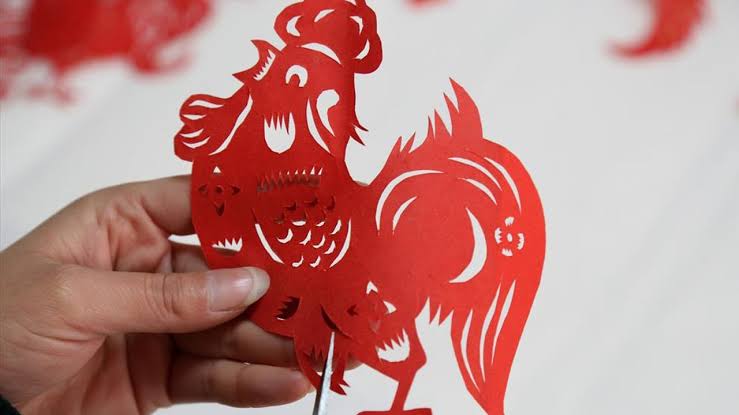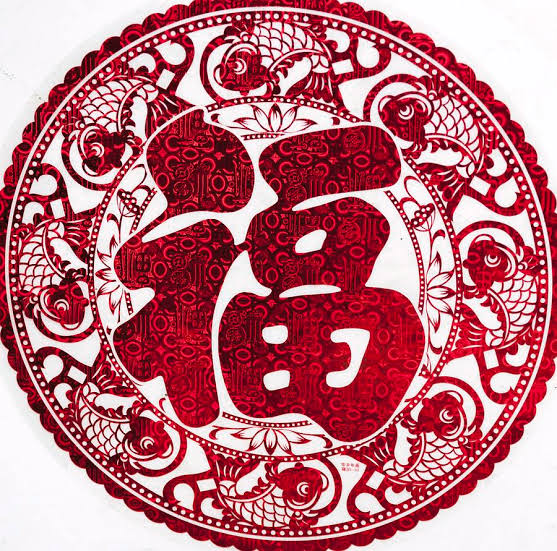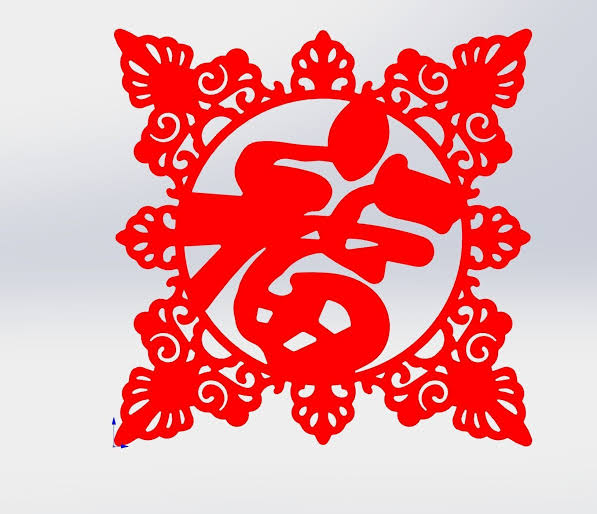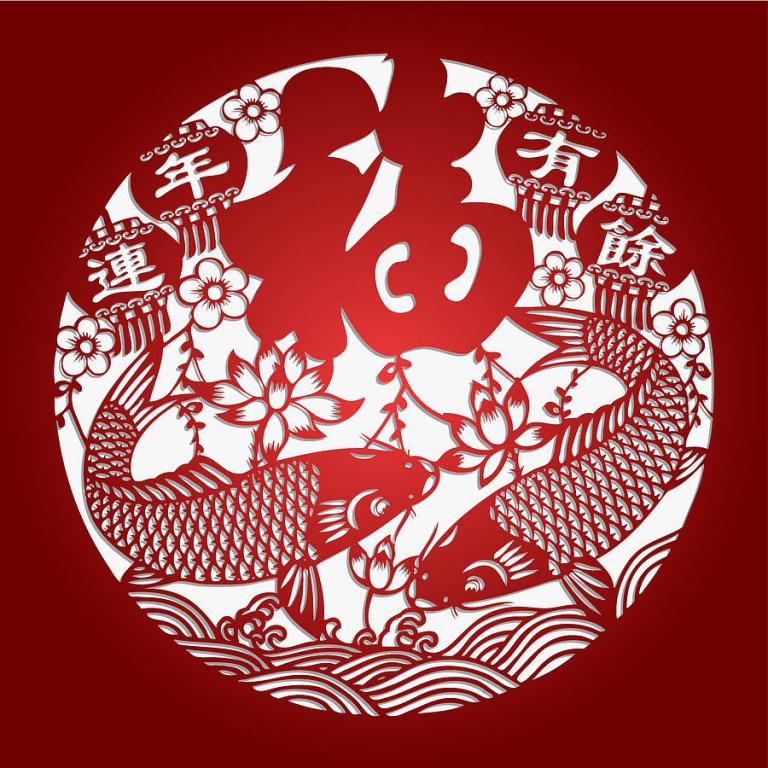Chinese Paper-cut
8 min readCut from different angles, you get different types of paper-cuts. By theme and content, there are figure, animal, flower, landscape, pattern, character, etc, paper cuts; by making skill, there are cut paper and engraved paper, or monochrome, complex-color, color filling and coloring paper-cuts; by connotation there are seasona event and folklore, historical story, real life paper-cuts; by function, there are paper cuts pasted on panes, on doors, on lanterns, on ceiling, or ceremonial paper-cuts and paper-cut ornaments.

In terms of function, paper-cuts pasted on panes are specifically for the chinese New year designed to ring out the old year and ring in the new year and decorate the house. In the largest quantity among paper-cuts, they are the centralized demonstration of the characteristics of paper -cutting the content includes the good fortune and joy, bumper harvest, booming family and livestock, precious flowers and auspicious birds, as well as popular opera characters and historical stories, in the shape of square, circular, strip and freedom shape, in red dyed colors and colored outline Paper-cuts posted on the door, sunblind, shrine, cabinet, etc, resemble thesmall flag or banner based on auspicious words or geometric patterns in red or five colors-red, green, yellow, pink, and violet. Usually, people would post singular number of paper-cuts, such as five on the gate, but sometimes one, three or sevenPaper-cut pasted on lanterns for the Lantern Festival, are mostly for praying forsafety wealth and longevity and sometimes about opera characters and patterns the shape and structure is made according to the shape of the lantern and the effect of shadow after candles lighting paper -cut pasted on ceiling is for creating a three dimension effect in the room. Apart from Spring Festival, people will also decorate the room for the new couple with paper-cuts. Ceremonial paper-cuts are for life rituals,e wedding, birthday, funeral, and mostly for wedding and birthday. Paper-cut ornaments are for wearing or decorating, with the pattern based on the position they are used for Paper-cuts always express certain themes through homophonic and implying Homophonic paper-cuts, in the shape of certain animals, plants, objects, imply good fortune and wealth, longevity and having many children For example, the chicken paper-cut implies fortune, sheep luck, fish deposit, deer emolument, bat blessing, chee benefit, and so on. As for the implying paper-cuts, they show the”auspicious meaning by imitating the attribute, feature and activity of animals, plants and vessels, but not as direct as the homophonic paper-cut. For example, the mandarin duck, loong and phoenix refer to couples, flat peach longevity, peony wealth and rank, pomegranate and cucurbit mean having many sons and grandsons, scorpion, gecko, viper, centipede and toad refer to five poisonous creatures”and a pair of scissors added to mean eliminating the five poisonous creatures.

As for the color and craftsmanship, monochrome paper-cuts are relatively easy to make, drawing draft, cutting with scissors and engraving with knife. Two overlapping papers can be cut together, and twenty thirty or even a hundred papers, put on a mixture of ash and animal fat, engraved together. In addition, there are chromatic paper cutting and engraving, dyed paper cutting and engraving, golden paper cutting and engraving, etc. the chromatic paper cutting and engraving means that a picture is made up of two or more cut and engraved parts in different colors, dyed paper cutting and engraving refers to that drop the staining fluid onto the engraved paper so that the colors interpenetrate into each other but remain orderly, achieving a bright and beautiful and multiple colors effect, very ethnically featured. And the golden paper cutting and engraving is that cut the golden paper into different patterns, and place papers of different colors underneath the pattern For example, place the red paper underneath the pattern of flowers, and green paper leaves, just resplendent and magnificent, usually for the baldachin of the wealth god and festivals
Engraving methods of paper-cuts are rilievi, intaglio, and rilievi and intaglio using together. The rilievi is derived from Chinese line drawings and the paper-cuts made with rilievi are as fine as the hair, just exquisite and delicate. On the other hand, the intaglio, making use of the cutout effect, stands out the bright points or white lines against the black or dark objective image, resulting in a simpler and more imposing effect compared with rilievi Rilievi and intaglio using together further enriches the paper -cuts
To be in line with folk custom, paper-cuts are strongly regional. In general, typical paper-cuts in northern China are from Shaanxi, Hebei, and Shandong, simple and vivid full of element of daily life, vigorous and naive, rough and freehand, plain and exaggerating, mostly made of a large piece of paper, and with intaglio method applied In southern China, typical paper-cuts are from Hubei, Guangdong, and Fujian, being exquisite delicate and lifelike known for its elegance and with rilievi method usuall applied. Primarily, they are crescent supported with zigzag, and lines are fine and smooth
Chinese paper-cut art came into being after the emerging of iron tools and papermaking technology, in the han and Wei period. Long before the paper produced.carving process had been well developed the excavated gold and silver piece ornaments of Warring states Period to the jin dynasty bear great resemblance to the paper-cut In Western Han Dynasty, people began to use hemp fiber to make paper As legend goes that after the death of the beloved concubine of Emperor Wu (156-87BC) in han dynasty the empire was immersed in endless missing. Then he let technicians cut hemp paper into the image of his concubine to call back her spirit That must be the earliest paper -cut two round-pattern paper -cuts of northern and Southern Dynasties unearthed in Gaochang ruins in Xinjiang are probably the earliest paper-cut ever found in China. Made of hemp paper, folded together, the two paper cuts were for sacrifice. The art expression way was mature Papermaking technology had been mature in Song Dynasty, and the wide variety of papers worked for the popularity and the rich variety of paper-cut, including the paper-cuts pasted on the gifts, window, lantern, and tea cup. Paper-cut has been used in artworks in the Song Dynasty. For instance, in Jizhou kiln in Jiangxi, paper-cutswere pasted onto the porcelain in the glazing process, and then put into the kiln to bake. This kind of porcelain enjoyed rich patterns and subjects, and lovely shape Scope of application of paper-cuts in Song dynasty further expanded: Shadow figuresof donkey, cattle, horse, sheep and other animals were carved with leather with the process of paper-cut; the engraved pattern platemaking for producing blue cloth with design in white was chased with oil paperboard; craftsmanship of paper-cut(intaglio and rilievi) was also applied to the flower pattern sample plate for scrape-paste printing. By then, there were some craftsmen cut paper for a living. They were proficient at different skills: some good at cutting characters of many schools, someother “multiple colors and patterns. The Zhiyatang Zachao(Miscellanies of Zhiya Hall) of Zhou Mi(1232-1298) in Song Dynasty recorded a paper-cut artist Yu Jingzhi, the first man had his name recorded in Chinese paper-cut history During the Ming and Qing dynasties, the paper-cut art stepped into mature and reached its heyday. The folk paper-cut art was more extensively used. Paper-cut ornaments or patterns were generally used in festive lanterns, covering of fans and embroidery, etc. For example, the clip gauze lantern in Ming Dynasty(present trotting horse lantern a lantern adorned with a revolving circle of paper horses) was a lantern clipping the paper-cut into the gauze and reflecting its pattern by virtue of candlelight, which embodied the paper-cut’s ordinary application the common people preferentially used the paper-cut to make home furnishing decoration, beautify home environment, such as sticking it on the lintel of a door, the window, cabinet, housetop, or using it in a wedding

In the period of the republic of China, paper-cut reached a higher level in pattern form and function, showing the prevailing custom of new times. As the western material culture was spread into China, new and old paper-cut patterns collectively integrated and developed; in addition to traditional flower, bird, insect, fish, figure, implement character, etc. many fresh and unique patterns were seen such as”five generations living together, “electric fan and kerosene lamp on the old-fashioned square table for eight people, train, car and bicycle in the picture of flying kites in the outskirts. The paper-cut was also widely in commercial advertising, book decoration, even the publicity for sports meeting and artistic performance. Plenty of tougher gold or silver paper and colorful calendered paper were used besides the traditional red paper and some thin blue, green, orange, purple and other colored paper.
In early days of the People’s Republic of china, the paper-cut art steadily it was eliminated during the”cultural revolution”and once totally disappeared and g recovered, however considered as “old ideas, old culture, old customs, and old habi was on the verge of extinction. Since 1980s, it gradually recovered and continued to be used by common people and also was honored as work of art for appreciation Many paper-cut craftsmen whose forefathers have been engaged in it began to be theprofessional artists, with their works keeping the original feature in the country Zhang Yongshou(1907-1989), born in an old and well-known paper-cut family in Yangzhou, was awarded the title of First Batch of Chinese Arts And Crafts Master His works are featured by exquisite and delicate, lively and vivid patterns, integrated various techniques with cutting, carving and hollowing out as the mainstream, such as paper-tearing, burning, color matching, dyeing and delineation, etc. Different fo can stick and set off each other, also can be hung, which strongly presents the orms expressive force of paper-cut art display in various patters, mostly being flowers and birds, and show exquisite paper cutting techniqu 33
Women are the main force engaged in Chinese folk paper-cut crafts. Mastering domestic arts is a major evaluation criterion for traditional perfect Chinese women. Asone of required technique of the domestic arts, paper-cut was a craft that girls shall learn in the childhood from their predecessors or sisters. They depicted familiar and Favorite things, such as plants and animals in the natural world and pavilions, bridges and landscape, through replicate cut, over lapping cut and drawing cut and other approaches, eventually they even can conveniently cut new patterns at will Ku Shulan(1920-2004), known as Paper-cut Lady was born in Xunyi County, Shaanxi Province, China, whose works have concise and clear style and bright colors She broke the tradition of simple imitation and created the clip art mode expressing the true, the good and the beautiful in one’s own soul. She never prepared a draft and just cut freely without too much hesitation, and pasted conveniently to depict pictures demonstrating China’s wonderful rural life. Her works told good and evil, ing philosophy, and cultural comprehension with full composition, plain character shapes, and bright and harmonious colors. In 1996, she was granted the title of Outstanding Chinese Folk Arts Master”by UNESCO
In 2009, Chinese paper-cut was included in the fourth batch of Representative listof the Intangible Cultural Heritage of Humanity upon approval of Intergovernmental Committee for the Safeguarding of the intangible Cultural Heritage. Rooted and spread among common people, Chinese paper-cut art is time-honored and fresh like the ancient and evergreen ivy









